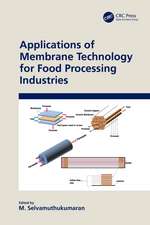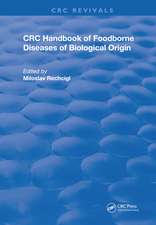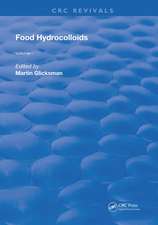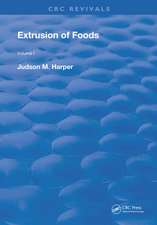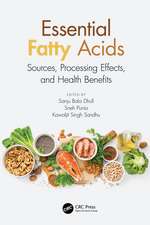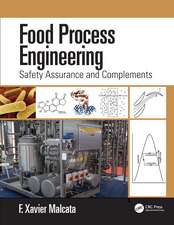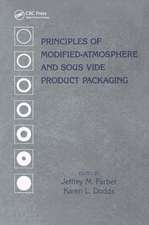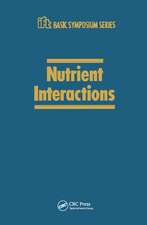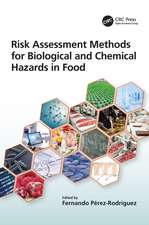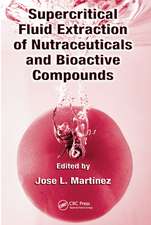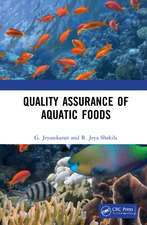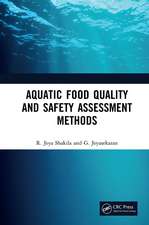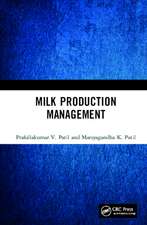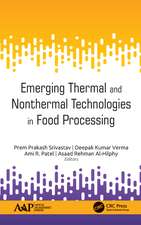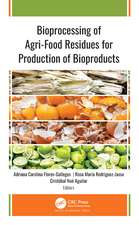The Farinograph Handbook: Advances in Technology, Science, and Applications: Woodhead Publishing Series in Food Science, Technology and Nutrition
Editat de Jayne E. Bock, Clyde Donen Limba Engleză Paperback – 10 mai 2022
This handbook is ideal for dough rheologists, cereal scientists, food (specifically, bread) scientists, millers, grain developers, academics, researchers and students.
- Acts as an authoritative source for information regarding the farinograph and its use
- Provides full coverage of the principles governing the instrument, its operation and application of results
- Contains a troubleshooting section which addresses common issues encountered with the instrument
- Covers information on potential sources of error and how to avoid or control them
- Equips the reader to determine when an instrument requires maintenance and/or repair
Din seria Woodhead Publishing Series in Food Science, Technology and Nutrition
- 15%
 Preț: 391.19 lei
Preț: 391.19 lei - 24%
 Preț: 1333.02 lei
Preț: 1333.02 lei - 24%
 Preț: 1210.03 lei
Preț: 1210.03 lei - 24%
 Preț: 946.43 lei
Preț: 946.43 lei - 9%
 Preț: 1205.99 lei
Preț: 1205.99 lei - 24%
 Preț: 1189.10 lei
Preț: 1189.10 lei - 9%
 Preț: 984.09 lei
Preț: 984.09 lei - 9%
 Preț: 1006.66 lei
Preț: 1006.66 lei - 24%
 Preț: 960.56 lei
Preț: 960.56 lei - 23%
 Preț: 1419.50 lei
Preț: 1419.50 lei - 9%
 Preț: 1206.85 lei
Preț: 1206.85 lei - 9%
 Preț: 922.07 lei
Preț: 922.07 lei - 24%
 Preț: 1192.22 lei
Preț: 1192.22 lei - 9%
 Preț: 1215.75 lei
Preț: 1215.75 lei - 24%
 Preț: 1162.37 lei
Preț: 1162.37 lei - 9%
 Preț: 950.09 lei
Preț: 950.09 lei - 24%
 Preț: 1162.62 lei
Preț: 1162.62 lei - 24%
 Preț: 801.31 lei
Preț: 801.31 lei - 27%
 Preț: 379.84 lei
Preț: 379.84 lei - 29%
 Preț: 1336.07 lei
Preț: 1336.07 lei - 24%
 Preț: 798.74 lei
Preț: 798.74 lei - 9%
 Preț: 1018.93 lei
Preț: 1018.93 lei - 24%
 Preț: 1081.43 lei
Preț: 1081.43 lei - 24%
 Preț: 1185.22 lei
Preț: 1185.22 lei - 31%
 Preț: 922.77 lei
Preț: 922.77 lei - 24%
 Preț: 1131.77 lei
Preț: 1131.77 lei - 23%
 Preț: 1635.86 lei
Preț: 1635.86 lei - 9%
 Preț: 1277.62 lei
Preț: 1277.62 lei - 24%
 Preț: 1049.04 lei
Preț: 1049.04 lei - 24%
 Preț: 1134.60 lei
Preț: 1134.60 lei - 9%
 Preț: 1076.36 lei
Preț: 1076.36 lei - 24%
 Preț: 1158.21 lei
Preț: 1158.21 lei - 9%
 Preț: 1065.06 lei
Preț: 1065.06 lei - 9%
 Preț: 1067.39 lei
Preț: 1067.39 lei - 24%
 Preț: 812.03 lei
Preț: 812.03 lei - 9%
 Preț: 1203.13 lei
Preț: 1203.13 lei - 23%
 Preț: 1237.19 lei
Preț: 1237.19 lei - 24%
 Preț: 948.79 lei
Preț: 948.79 lei - 23%
 Preț: 1138.06 lei
Preț: 1138.06 lei - 9%
 Preț: 868.43 lei
Preț: 868.43 lei - 24%
 Preț: 871.98 lei
Preț: 871.98 lei - 20%
 Preț: 1272.59 lei
Preț: 1272.59 lei - 29%
 Preț: 1195.06 lei
Preț: 1195.06 lei - 9%
 Preț: 1045.58 lei
Preț: 1045.58 lei - 9%
 Preț: 1002.45 lei
Preț: 1002.45 lei - 9%
 Preț: 505.72 lei
Preț: 505.72 lei - 9%
 Preț: 1062.13 lei
Preț: 1062.13 lei - 24%
 Preț: 1306.94 lei
Preț: 1306.94 lei
Preț: 1064.20 lei
Preț vechi: 1397.56 lei
-24% Nou
203.70€ • 221.34$ • 171.22£
Carte tipărită la comandă
Livrare economică 14-28 aprilie
Specificații
ISBN-10: 0128195460
Pagini: 270
Dimensiuni: 191 x 235 mm
Greutate: 0.47 kg
Ediția:4
Editura: ELSEVIER SCIENCE
Seria Woodhead Publishing Series in Food Science, Technology and Nutrition
Public țintă
Farinograph users, dough rheologists, cereal scientists, food (specifically, bread) scientists, millers, grain developers, academics, researchers, and studentsCuprins
Part One: Instrument 1. The Farinograph 2. Principles of Farinograph operation and factors affecting performance 3. Understanding Farinograph torque curves 4. Dough rheology and the Farinograph
Part Two: Applications 5. Using the Farinograph in daily operations 6. Hard wheat products 7. Soft wheat products 8. Whole wheat products 9. Specialty products (durum and gluten-free products) 10. Using the Farinograph/Do-Corder/Plasticorder as a torque rheometer for difficult to measure biological materials 11. Advanced research applications
Part Three: Appendices A: Bowl cleaning and maintenance B: Calibration C: Troubleshooting D: Legacy information
Descriere
The Farinograph Handbook: Advances in Technology, Science and Applications, Fourth Edition, highlights the instrument’s changes over the last three decades. This book outlines how different farinograph models work, how to properly run a standard test and interpret the results, and the standard and unconventional applications for the instrument. This fourth edition will familiarize readers with the farinograph instrument’s principles of operation and factors that affect its operation. This edition also contains new research on dough rheology, the use of results for process control in traditional bakery applications, and information on instrument maintenance and calibration.
This handbook is ideal for dough rheologists, cereal scientists, food (specifically, bread) scientists, millers, grain developers, academics, researchers and students.
- Acts as an authoritative source for information regarding the farinograph and its use
- Provides full coverage of the principles governing the instrument, its operation and application of results
- Contains a troubleshooting section which addresses common issues encountered with the instrument
- Covers information on potential sources of error and how to avoid or control them
- Equips the reader to determine when an instrument requires maintenance and/or repair


